Greenhouses are versatile structures that allow gardeners and horticulturists to extend growing seasons, cultivate exotic plants, and shield delicate seedlings from harsh weather. Yet, selecting the right greenhouse for your specific needs can be a challenge. From determining the best materials to understanding climate control systems, a range of factors play into making this significant investment successful. Whether you’re a small-scale hobbyist or an aspiring commercial grower, this in-depth guide will help you narrow down the essential considerations when choosing your ideal greenhouse.
1. Clarify Your Purpose and Goals
Before diving into technical specifications, get clear about why you want a greenhouse and what you plan to grow. Each gardener’s goals can be unique, so refining your objectives will shape decisions about design, size, and features.
- Season Extension: If you primarily want to extend your gardening season by a few weeks on each end, a simple, medium-size greenhouse might suffice. This structure will protect your plants from early frosts in the fall and allow earlier planting in spring.
- Year-Round Growing: If you aim to grow crops 12 months of the year, you may need a more robust greenhouse with heating, cooling, and additional insulation.
- Starting Seedlings: Some gardeners only need a space for germinating seeds before moving them outdoors. In this case, a smaller greenhouse or even a cold frame might be enough.
- Specialty or Exotic Plants: If you want to raise orchids, tropical fruits, or other sensitive species, your greenhouse must accommodate precise humidity and temperature controls.
The clearer you are about how you’ll use the greenhouse, the more strategically you can choose its size, structure, and features.
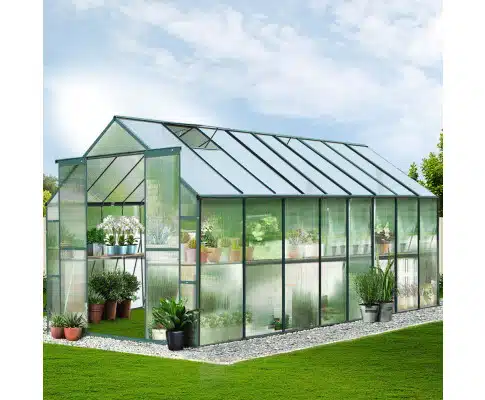
2. Consider the Location and Orientation
Once you have a vision for your greenhouse, location is the next big decision. Where you place it and how it’s oriented will significantly influence light exposure, temperature stability, and ease of maintenance.
- Sunlight Exposure: Greenhouses ideally need at least six hours of direct sunlight daily. Position the structure to receive maximum sun, typically with its longest side facing south (in the Northern Hemisphere) or north (in the Southern Hemisphere) to optimize sunlight capture.
- Wind Patterns and Shelter: Strong winds can cause heat loss, increase wear and tear, and damage fragile plants. If possible, select a spot that’s sheltered by natural windbreaks (like hedges, fences, or other buildings), or consider adding windbreak features around your greenhouse.
- Access and Convenience: If you’ll be frequently transporting supplies, water, and tools to the greenhouse, situate it near an accessible pathway. A greenhouse tucked too far away in your yard may discourage regular checks and maintenance.
- Ground Stability: You’ll need level or appropriately graded ground to ensure stability, adequate drainage, and a simpler installation process. Uneven or waterlogged terrain can lead to structural issues and reduced plant health.
Taking time to choose and prepare the right site can dramatically improve your greenhouse’s efficiency and your overall growing success.
3. Selecting the Frame Material
A greenhouse’s frame provides the skeleton upon which glazing (panels) rests. Strong and durable frames can withstand the elements, whereas weaker frames risk collapsing under snow or high winds. Common frame materials include:
- Aluminum: A popular choice due to its lightweight nature, corrosion resistance, and relatively easy assembly. Aluminum frames often come in kits, making them beginner-friendly. However, they can be less thermally efficient unless paired with insulation strategies.
- Galvanized Steel: Heavier and sturdier than aluminum, galvanized steel frames can handle harsher weather conditions. However, they might be more challenging to assemble and can also rust if the galvanizing layer is compromised.
- Wood: Wooden frames offer a classic, natural look and good insulation properties. Cedar is a particularly common choice due to its rot resistance. The downside is that wood frames require more maintenance—treating, staining, or sealing—over time, and can be costlier up front.
- PVC or Plastic: These frames can be cost-effective for smaller structures. PVC is lightweight and easy to handle, but it may be less durable in severe climates. Also, prolonged UV exposure can degrade lower-quality plastics, so ensure you choose UV-resistant PVC if going this route.
The frame is the backbone of your greenhouse. Invest in quality materials that match your local weather and the structure’s intended lifespan.
4. Glazing Options: From Glass to Polycarbonate
The glazing material (the transparent or translucent covering) has a profound effect on light transmission, insulation, and overall greenhouse performance. Here are the main choices:
- Glass: Traditional glass offers high light transmission and a classic aesthetic. Tempered or horticultural glass is commonly used for better strength and safety. While glass is excellent for clarity, it’s heavy, can shatter under stress, and may require a stronger frame. Also, single-pane glass has lower insulation properties compared to double-glazed options.
- Polycarbonate: A popular modern choice, polycarbonate panels are lightweight, durable, and offer good insulation—especially in double-wall or triple-wall configurations. They diffuse sunlight more evenly, reducing the risk of hot spots on plants. Their main drawbacks can be a slightly lower light transmission than glass (particularly in multi-layer panels) and potential yellowing or scratching if using lower-quality panels.
- Acrylic (Plexiglass): Similar to polycarbonate in weight and insulation, though typically more expensive. Acrylic panels resist UV degradation better than some polycarbonates, retaining clarity over a longer period. They can, however, crack more easily under impact compared to certain polycarbonate grades.
- Polyethylene Film: For budget-conscious gardeners or commercial operations needing large-scale coverage, plastic films are common. Easy to install and replace, they have good heat retention but lower durability and may need frequent replacement depending on thickness and UV treatment.
Choosing the glazing material is often about balancing cost, longevity, clarity, and insulation. Polycarbonate tends to be a go-to for many hobbyists, while glass remains the premium choice if you prioritize aesthetics and clarity.
5. Ventilation and Airflow
Sufficient ventilation is vital to prevent heat buildup, regulate humidity, and maintain fresh air circulation around your plants. Without proper airflow, greenhouses can quickly overheat on sunny days, stressing or killing your plants.
- Roof Vents: The most effective greenhouse ventilation typically includes roof vents, which allow hot air to escape from the top. Automatic roof vent openers (which operate on a temperature-sensitive mechanism) can make management easier.
- Side Vents: Louvered side vents or roll-up sides (in some tunnel greenhouses) allow cooler air to enter at lower levels, displacing hot air rising to the roof. Combined with roof vents, side vents create a natural “chimney effect” that efficiently cools and cycles air.
- Fans and Forced Ventilation: If you live in a hot climate or have a fully enclosed greenhouse, installing one or more fans can help push hot air out and pull cool air in. Some growers add thermostats or controllers that automatically activate fans at certain temperatures.
- Circulation Fans: Even in moderate climates, small circulation fans can help keep air moving, reducing temperature and humidity extremes that otherwise foster diseases like mildew or rot.
Optimal ventilation can often make the difference between a greenhouse that’s a joy to maintain and one where plants continually suffer from overheating or mold.
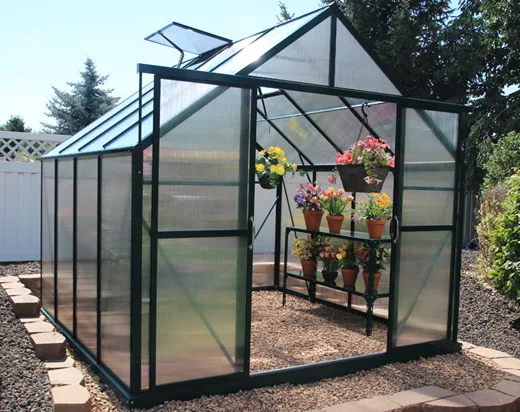
6. Heating, Cooling, and Climate Control
If you plan to use your greenhouse beyond mild weather or want to grow specialty crops, you’ll likely need more rigorous climate control systems. These can include:
- Heating Systems:
- Electric Heaters: Common for smaller greenhouses, as they are straightforward to install and do not emit fumes.
- Gas or Propane Heaters: Potentially more cost-effective for larger spaces, but you must vent carbon dioxide and moisture properly.
- Radiant Heating: Under-bench or in-floor radiant systems can warm root zones efficiently, promoting strong plant growth.
- Cooling Strategies:
- Shade Cloth or Paint: Placing shade cloth over the greenhouse or applying shade paint to the glazing can reduce solar heat gain.
- Evaporative Coolers (Swamp Coolers): Especially popular in drier climates, they pull air through a wet pad, lowering inside temperatures.
- Air Conditioning: Rarely used for small hobby greenhouses due to high energy costs, but occasionally found in specialized or commercial setups.
- Thermostats and Automatic Controls:
- Thermostats tied to heaters, fans, or vents let you maintain a stable temperature. Advanced controllers can also manage humidity, CO₂, or lighting schedules.
- Smart greenhouse systems allow remote monitoring and adjustments via mobile apps, useful if you’re often away from home.
Balancing temperature and humidity is crucial. Carefully weigh your local climate demands, the insulation of your greenhouse, and how intensively you plan to grow before investing in advanced climate systems.
7. Size and Layout: Think Big (But Within Reason)
A common regret among greenhouse owners is buying one that’s too small. Even if you don’t plan to fill it right away, having extra space can prevent overcrowding and allow better movement inside the greenhouse. However, going too large can strain your budget, increase energy costs, and overwhelm your yard.
- Assess Your Available Space: Measure your planned location carefully. Remember that you’ll also need room to move around the exterior for maintenance and cleaning.
- Plan Your Growing Layout: Think about how many tables, benches, or hydroponic systems you want inside. Are you growing vertically with hanging baskets? Will you add shelving along the walls?
- Future Expansion: If you anticipate significantly expanding your gardening in the next few years, consider a modular greenhouse design or a slightly larger footprint from the start. Retrofitting or expanding later can be more costly.
- Walkways and Ergonomics: Plan at least one main walkway that lets you move equipment and comfortably tend to plants. Narrow aisles can make watering, pruning, or harvesting a chore, especially with larger containers or raised beds.
Choosing the right size is a balancing act. Sketch potential layouts and factor in space for accessories, heating equipment, storage, and comfortable workspace before making a final decision.
8. Foundation and Flooring
A greenhouse’s foundation impacts its durability, temperature stability, and ease of maintenance. Common foundation and flooring options include:
- Concrete Slab: Durable and easy to clean, a concrete base can also retain and radiate heat, helping regulate nighttime temperatures. However, it can be expensive and may not allow for easy drainage unless properly sloped or fitted with drains.
- Gravel Base: A simpler approach is to lay down a gravel bed. It helps with drainage and can be topped with weed-blocking landscape fabric. Some owners find it less convenient for wheeled carts or cleaning but appreciate its affordability.
- Wooden Base or Deck: Using rot-resistant timber, you can build a raised platform for the greenhouse. This can be visually appealing and warmer underfoot. Ensure the wood is sealed and that any joists underneath are well-ventilated to avoid rot.
- Pavers or Bricks: Installing pavers allows for decent drainage between the joints and a durable walking surface. It can be time-consuming to set up properly but provides a charming, classic look.
Make sure to anchor the greenhouse securely, especially if you live in an area with high winds. A well-built foundation will help the structure last and maintain a stable environment for your plants.
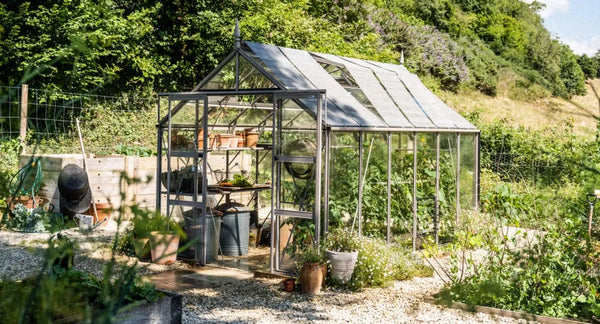
9. Additional Features and Accessories
Beyond the basic structure, numerous add-ons can elevate your greenhouse’s functionality:
- Shelving and Benches: Adding sturdy tables or tiered shelving can maximize vertical growing space. Opt for moisture-resistant materials like metal or treated wood.
- Automatic Irrigation: Drip lines or misting systems can save hours of manual watering, especially in a larger greenhouse with many plants.
- Lighting: If you plan to grow in shorter daylight months or cultivate light-hungry species, supplemental grow lights can ensure consistent plant development. LED lights are often the most energy-efficient choice.
- CO₂ Enrichment: Commercial growers sometimes install CO₂ generators to boost growth rates in a tightly sealed greenhouse. This is typically an advanced strategy not required for casual hobbyists.
- Monitoring Equipment: Thermometers, hygrometers, and soil moisture meters all help keep track of conditions. Some advanced gardeners employ data loggers or automated controllers that combine multiple sensor inputs.
- Rainwater Collection: If your greenhouse design includes gutters, you can collect rainwater for eco-friendly irrigation. Just be sure your local conditions and roofing materials allow for safe water collection.
Adding these accessories might increase your initial budget, but they can significantly improve plant health and reduce day-to-day labor.
10. Budget Planning and Long-Term Investment
Greenhouses vary widely in cost, from budget plastic pop-up models to elaborate, custom-built structures. While it’s tempting to opt for the cheapest option, consider how long you expect the greenhouse to last and the return you’ll gain from healthier, more prolific plants.
- Initial Cost vs. Durability: A well-constructed greenhouse might outlast several cheaper alternatives, saving on repairs and replacements over time. Sturdy frames, quality glazing, and a proper foundation can mean less maintenance.
- Operating Expenses: Heating and cooling can become major expenses if you’re growing year-round or in extreme climates. Evaluate how well your chosen materials retain heat and whether your design minimizes unnecessary energy use.
- Maintenance: Will you need to replace glazing every few years? Are spare parts easily available if a panel cracks? Are the frames prone to rust or rot if not regularly treated? Budgeting for ongoing maintenance is essential.
- Resale Value: A durable, visually pleasing greenhouse can add charm and value to your property. If you plan to move or sell in the foreseeable future, a well-maintained greenhouse might be an appealing feature for potential buyers.
Ultimately, a greenhouse is more than just a financial transaction—it’s an investment in gardening enjoyment, self-sufficiency, and the ability to cultivate plants that would otherwise be challenging or impossible in your region’s climate.
11. Local Regulations and Permits
Depending on where you live, you might need to obtain permits or adhere to local zoning laws before installing a greenhouse. Some municipalities require building permits for permanent structures over a certain size, while homeowners’ associations (HOAs) might have restrictions on style or placement. Researching these details in advance can spare you headaches:
- Building Permits: Check if your proposed greenhouse size or foundation style requires a permit. Provide any necessary drawings or specs as requested by local authorities.
- Setbacks and Property Lines: Verify that your greenhouse location meets zoning requirements for distances from property boundaries and other structures.
- HOA Rules: Some HOAs have aesthetic or placement restrictions to maintain neighborhood standards. If applicable, submit design and color choices for approval.
- Utility Lines: Always ensure the greenhouse site does not overlap underground utility lines (gas, water, electrical) and that overhead lines won’t interfere with tall greenhouse structures.
Taking these steps helps avoid fines or the aggravation of relocating the greenhouse after it’s built.
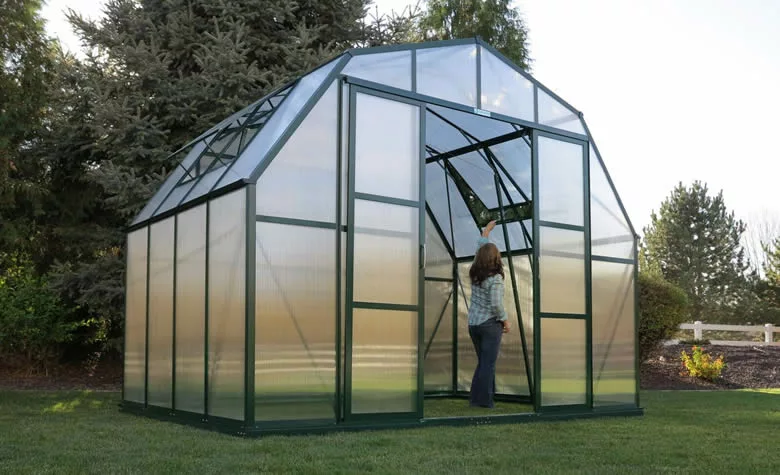
12. Sustainable and Eco-Friendly Practices
For many green-thumbed enthusiasts, sustainability is a core value. You can integrate eco-conscious choices into your greenhouse design and daily operations:
- Natural Materials: Selecting durable, responsibly sourced wood for the frame and using organic mulches or soil can reduce your environmental footprint.
- Passive Solar Design: Incorporate design elements like thermal mass (e.g., water barrels or stone flooring) to store heat during sunny days and release it at night. This approach can stabilize temperatures and reduce heating costs.
- Rainwater Harvesting: Gutters and downspouts can channel rainwater into barrels, providing irrigation water that’s free of the chemicals often found in municipal supplies.
- Composting Inside or Nearby: Place a small compost bin near or inside the greenhouse to recycle organic waste and feed nutrient-rich compost to your plants.
- Biological Pest Control: Emphasize beneficial insects (ladybugs, lacewings), companion planting, and minimal pesticide use to maintain a healthier greenhouse ecosystem.
Greenhouse gardening is inherently about harnessing sunlight for growth; implementing eco-friendly strategies can further enrich your horticultural journey while easing reliance on external resources.
13. Maintenance and Upkeep Essentials
Once your greenhouse is built, keeping it functional and tidy is key to getting the most from your investment:
- Regular Cleaning: Dirt, algae, and grime that accumulate on the glazing can reduce light transmission. Periodically wash both the exterior and interior with gentle, non-abrasive cleaners.
- Inspect Seals and Joints: Cracks or gaps in the glazing or frame can let warm air out in winter (or let hot air in during summer), undermining climate control. Reseal any compromised joints promptly.
- Monitor for Pests: Enclosed, warm environments can become breeding grounds for spider mites, aphids, and other pests. Monitor closely and address infestations early with organic or targeted pest control methods.
- Seasonal Adjustments: As seasons change, so do your greenhouse’s needs. You might remove or add a shade cloth, adjust thermostats, or install additional insulation in colder months.
- Check Equipment: Heaters, fans, and irrigation systems require occasional maintenance. Clean filters, test motors, and replace worn parts to keep everything running smoothly.
A consistent routine of inspection and upkeep prevents small problems from escalating and ensures you’ll enjoy a productive greenhouse for many years.
14. Planning Your Planting Schedule
A greenhouse is only as rewarding as the plants you nurture inside it. Part of the excitement is strategic crop planning to optimize space and conditions:
- Crop Rotation: Continuously replanting the same crops in the same area can deplete soil nutrients and encourage pests. Rotate plant families to keep soil healthier.
- Succession Planting: Stagger plantings (especially for fast-growing crops like salad greens or herbs) so you always have new seedlings ready to replace mature plants.
- Seasonal Transitions: Use the greenhouse for overwintering tender perennials, starting spring vegetables early, or maintaining winter greens. Each season can feature different sets of crops.
- Companion Planting: Placing complementary plants together (e.g., basil near tomatoes) can help deter pests and enhance flavors. Research which pairs work well in enclosed spaces.
- Record Keeping: Maintaining a simple journal or spreadsheet with planting dates, harvest yields, and noted challenges helps you refine your approach each year.
A methodical planting plan combined with a well-maintained greenhouse can lead to high yields of vegetables, flowers, or specialty crops even in less-than-ideal outdoor climates.
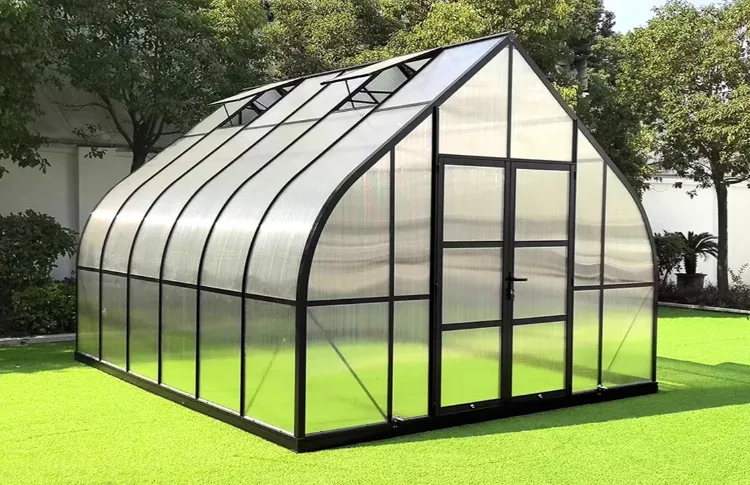
15. Conclusion: Bringing It All Together
Choosing a greenhouse is about striking a balance—between budget and ambition, climate demands and structural capacities, short-term needs and long-term visions. By focusing on key factors like purpose, location, structure, glazing, ventilation, and climate control, you can make an informed decision that fits your gardening goals. Whether you opt for a compact, budget-friendly polycarbonate model or a spacious, high-end glass structure, investing time and thought in the planning stage will pay off with a healthy, flourishing indoor garden.
A greenhouse can transform your relationship with plants, offering you a sanctuary to experiment, cultivate new varieties, and enjoy fresh produce year-round. Beyond the tangible rewards of a bountiful harvest or vibrant blooms, a greenhouse can be a peaceful retreat—your own corner of nature that remains welcoming regardless of the season’s extremes. By taking into account the considerations laid out in this guide—sizing, materials, climate control, and more—you’ll be well on your way to selecting a greenhouse that stands the test of time and delivers a steady flow of botanical delights. Happy growing!
